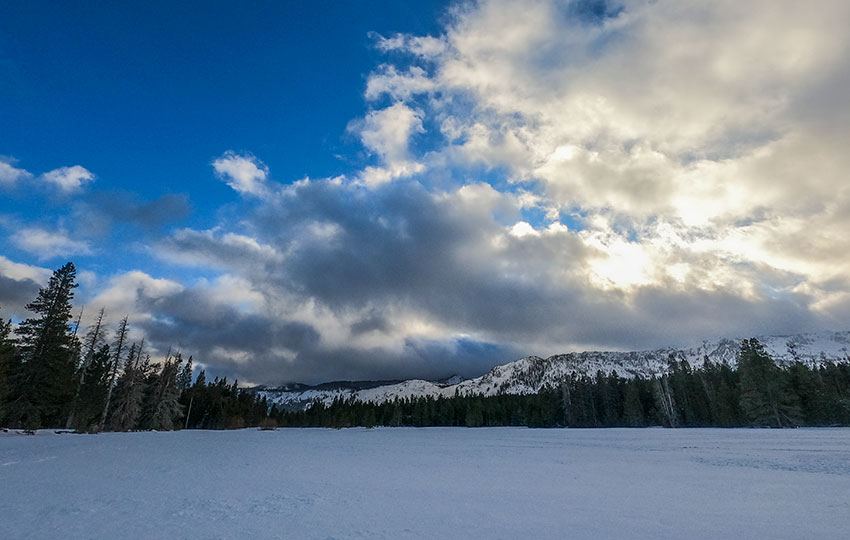
New cross-country skiers looking to buy gear for the first time consistently ask me two questions. The first is whether or not they can buy one set of skis to use on groomed and backcountry terrain. My answer to that question is “technically yes, but functionally no.” Click the following linked text to read my article about the pitfalls of using one set of xc skis for all conditions.
The second question is essentially a follow-up question to the first. And it’s usually along the lines of “Can I use one set of ski boots for everything?”
Only owning one pair of xc ski boots makes sense. It saves you money and storage space. And, that one pair of boots is manageable. For example, I’ve seen people who own multiple boots and skis discover while unpacking their gear at the trailhead or resort that they brought the wrong boots or skis. With one pair of ski boots, you either have them or you don’t!
Believe it or not, though, I’ve met plenty of people who’ve forgotten their boots or skis altogether. I do work in a rental shop, after all, and I’ve seen just about everything imaginable go wrong for people simply trying to xc ski for the day.
Support Tahoe Trail Guide with a financial contribution via PayPal (single contribution) or Patreon (reoccurring contributions). Your support of Tahoe Trail Guide is very much appreciated!

So, I appreciate the logic behind wanting to own just one pair of ski boots for everything. Unfortunately, it’s not a great solution. This is because there are only a couple of scenarios in which multi-purposing one set of ski boots makes sense.
On the other hand, there are many instances where it wouldn’t be practical to use one boot for everything. In most of those cases, you’d just be disappointed by their lack of performance. But in other situations, you may end up wrecking your gear or yourself!
Situations in which One Set of XC Ski Boots is Appropriate
Before I dig into the deeper discussion of those less-than-ideal scenarios, I want to quickly discuss the easy ones.
You could use one pair of ski boots for multiple sets of similar styles of skis. The key, however, is that all of the skis in question have the same type of bindings.
- So, you could use one set of boots for all of your classic track skis so long as they have the same type of bindings.
- Also, you could use one set of xc ski boots for multiple sets of skate skis so long as they have the same type of bindings.
- Additionally, you could use a set of “combination” boots for your classic track skis and skate skis, so long as both sets of skis have the same type of bindings. Combination boots (aka combi-boots) are soft enough for diagonal striding, but also feature some ankle support for skate skiing. They are not necessarily designed for backcountry use, however.
- Lastly, you could use one set of boots for multiple sets of backcountry xc skis so long as they all have the same type of bindings.
I realize that I’m going overboard with the point about your skis needing to have the same type of bindings in order to use one set of boots. However, this is a critical point. It’s not the only factor to consider, but it’s essentially the starting point for our discussion.
Cross-Country Ski Binding Considerations
I said that the question of boots is often the follow-up to the one about an all-purpose set of skis. That’s because many people want the option of being able to ski at groomed xc ski resorts and in the backcountry. These two environments – groomed and ungroomed terrain – capture the interest of every cross-country skier for good reason.
We want to be able to ski everywhere!
Unfortunately, there’s not one cross-country ski that’ll adequately handle all terrain and snow conditions.
Again, I cover this topic in my companion article about using one set of xc skis for everything.
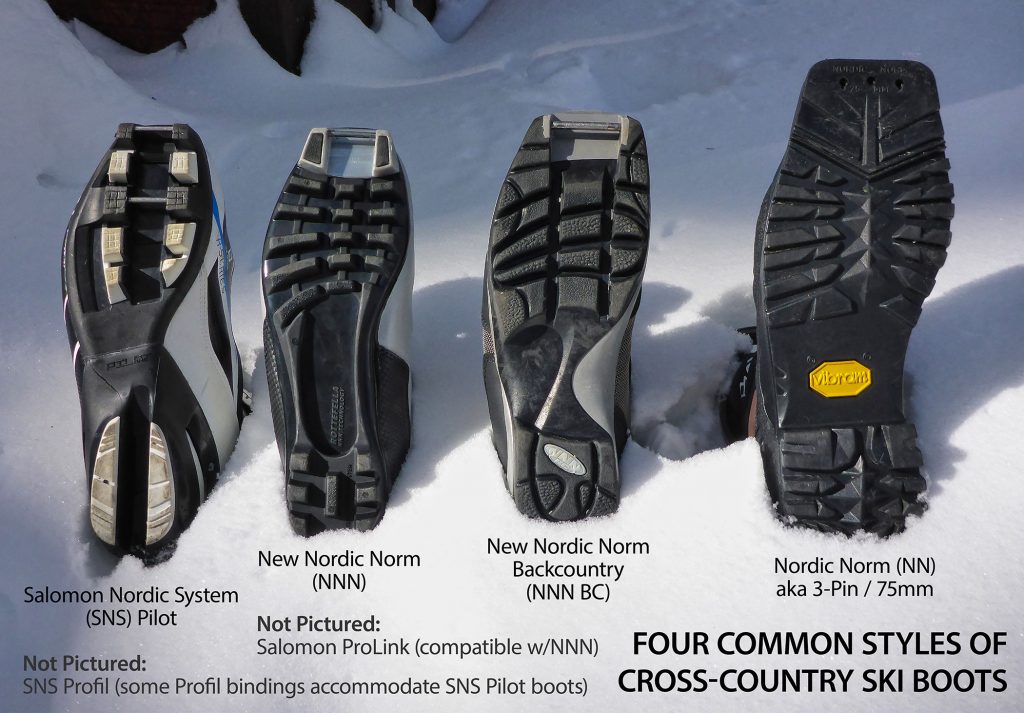
That said, the gist of my argument is that different styles of cross-country skiing and different environments require different gear. Obviously, this is not rocket science. However, many people don’t realize that all xc ski boots are not compatible with all xc ski binding systems.
In fact, you can find multiple versions of the same boot designed to be compatible with different binding systems. This is really evident with backcountry cross-country ski boots. For example, you can buy Alpina’s Alaska boot to be compatible with either an NNN BC (backcountry) or three-pin (75mm) binding system. Same exact boots except for the soles, which is where the binding compatibility component comes into play.
For a full rundown of classic cross-country ski boots read the article XC Skiing Explained (Part 5): Classic Cross-Country Ski Boots.
So, cross-country ski boots are directly related to cross-country ski bindings. Therefore, the crux of the problem behind using one pair of boots for multiple sets of skis is actually the binding system.
To add another layer of flavor to this recipe is the fact that certain bindings are designed for specific purposes and environments. I’ve talked about this elsewhere, specifically in my article that addresses cross-country ski bindings. However, I want to reference it again because it’s appropriate here.
Skiing on groomed terrain with track or skate skis only requires light-duty bindings (i.e. NNN/NNN-compatible, SNS Pilot/Profil).
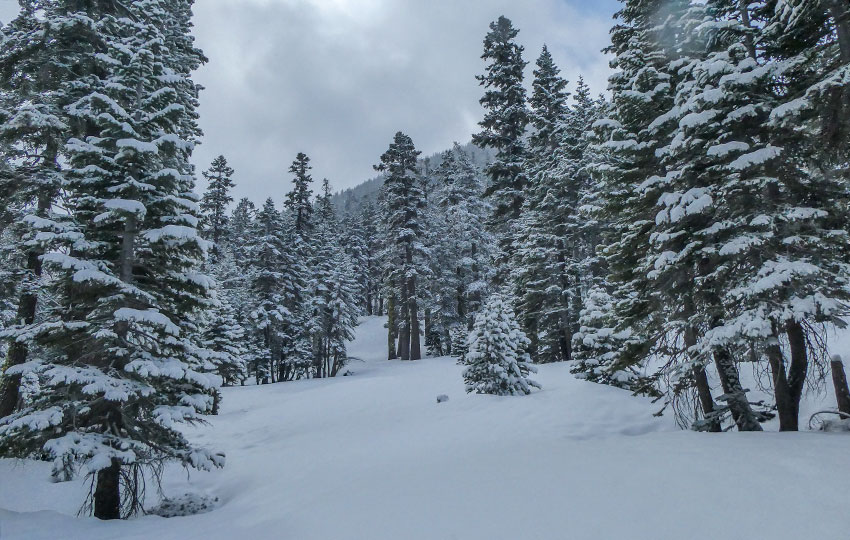
On the other hand, those same light-duty bindings are generally not sufficient for skiing in the backcountry. Variable terrain, steepness of angles, and depth of snow will wreak havoc on those little bindings.
Ultimately, light-duty bindings are just not strong enough to drive bigger backcountry xc skis. In essence, they become the system’s weak point. For example, if you mounted NNN bindings on Fischer S-bound 98s you’d eventually just snap the binding right off of the ski.
For the record, though, I do actually use a set of NNN bindings on one of my sets of Fischer Spider 62mm off-track skis. But I wouldn’t mount NNN bindings on a ski that’s any wider than 65mm. And I only run those skis when there’s very little snow or the snow is consistently firm and consolidated.
At the other end of the spectrum are backcountry-related bindings such as NNN BC (auto and manual) or three-pin. Rottefella’s Xplore XC bindings are also an option. However, I have yet to use them. Essentially, though, they’re an Alpine Touring lite binding system that’s geared toward backcountry use, particularly with an emphasis on the downhilling aspect.
I don’t recommend using heavier duty bindings on track skis. They’re simply too much binding for groomed terrain. This, in spite of the fact that three-pin (aka 75mm aka NN aka Nordic Norm) use to be the standard for all cross-country skis. Back in the day, however, those three-pin bindings were used to run longer and heavier skis. Today’s track and skate skis are so skinny and light that backcountry-oriented bindings hang too far over the edges. And, those more robust bindings place a lot of torque on the ski. This means that the ski now becomes the weak part of the system.
Styles of Cross-Country Skiing
Again, your selection of ski boots will be directly related to the type of binding for which they’re compatible. So keeping in mind the aforementioned types of cross-country ski bindings, let’s look at the various styles of skiing.
There’s classic cross-country skiing, which is also known as diagonal striding or traditional xc skiing. It’s a very linear looking style of skiing. Classic skiing has you running your skis in the parallel tracks at a groomed xc ski area.
There’s skate skiing, which is a very lateral moving style of cross-country skiing. Its motion loosely resembles that of ice skating. It’s also performed at a groomed cross-country area.
Lastly, there’s off-track or backcountry cross-country skiing. I consider backcountry skiing as being anything other than skiing at a groomed cross-country ski area.
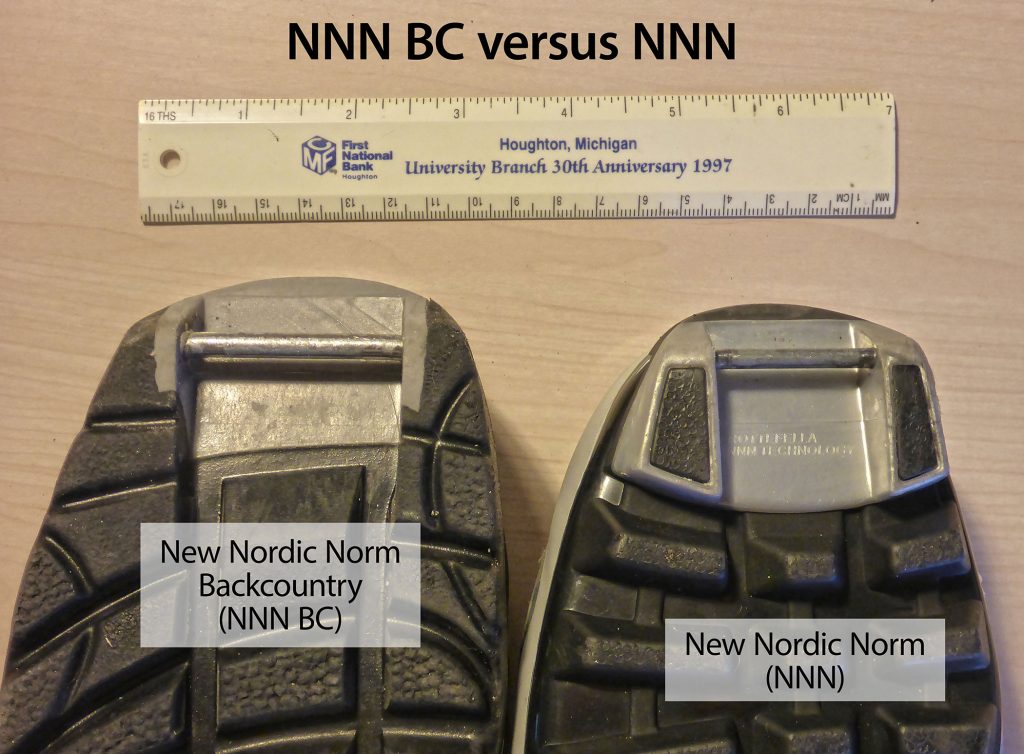
Classic/Traditional/Diagonal Striding
Your ankles, feet, and toes need to flex naturally when classic cross-country skiing. Essentially, diagonal striding is a modified form of walking or running. You’re always pushing off forward when diagonal striding. So, the boots need to reflect this natural human movement.
Since the foot and ankle motion is essentially forward and backward, you don’t want really stiff boots. Otherwise, they’ll prevent that natural movement which will then negatively affect your technique.
Generally speaking, most classic-oriented cross-country ski boots don’t offer much, if any, ankle support. Racing ski boots are essentially running shoes with a small gaiter fixed to them (preventing snow from going into the shoes).
Other classic boots will offer some upper ankle padding or insulation. However, this is to keep your ankles warm not to help with stability. And, the shoelaces of the boots will seldom lace above the ankle in a classic boot.
In theory, you shouldn’t need lateral stability in your classic ski boots. Diagonal striding technique is forward and linear, after all. Even when performing step turns around corners, for example, you’re essentially moving forward every time you put your ski down.
Making skate turns, on the other hand, does require you to push off laterally when rounding corners. However, skate turns are accelerating turns that most beginners seldom employ. And, the average person should have enough ankle strength to make a few lateral push-offs over the course of a ski session.
There are a million different varieties of classic xc ski boots available. However, in this context I’m referring to boots designed for use on groomed terrain. Therefore, this style of boot is primarily compatible with light-duty xc ski bindings.
Skate Skiing
I recommend stiff boots with upper ankle support for skate skiing. This is because, when skate skiing, you’re always pushing off laterally. Keep in mind that this is basically opposite of classic skiing, which mimics our natural forward movement (i.e. walking or running).
Since we’re always pushing off to the side when skate skiing, having that upper ankle support is key to efficient and effective technique. The additional ankle support of a dedicated skate ski boot prevents your ankles from bending awkwardly or excessively. And a boot specifically designed for skate skiing makes skating so much more enjoyable.
Skate ski boots are usually stiff to the point that classic skiing with them is nearly impossible. Trust me. Using a skate ski boot for diagonal striding absolutely sucks. They just aren’t soft enough, particularly in the toe box, to allow your ankles, feet, and toes to flex naturally like with a classic boot.
Skate ski boots are compatible with light-duty xc ski bindings. So, they’re designed for use on groomed terrain.
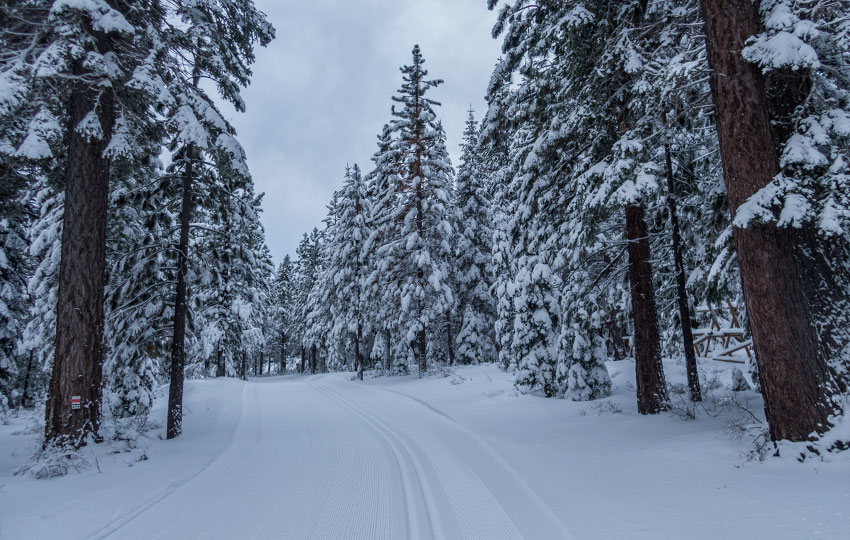
Combination Boots
I briefly mentioned combination boots earlier in this article. Essentially, combi-boots are cross-country ski boots that are softer in the foot (to allow for classic technique) but offer some upper ankle support (for skate skiing). Keep in mind that combi-boots are for combining classic skiing and skate skiing on groomed terrain. This combination doesn’t necessarily include backcountry cross-country skiing.
Combination boots are perfect for use at groomed cross-country ski areas. For example, you could use them for skate skiing in the morning on firm snow. And, then, you could use them again with your classic skis later in the day after the snow has softened up.
I still tend to prefer a dedicated classic boot for classic skiing and a dedicated skate boot for skate skiing. But, at the same time, a combination boot is more than adequate for both applications.
Since combination boots are for use on groomed terrain, they’re only compatible for light-duty xc ski bindings. Again, combi-boots are not really designed as backcountry cross-country ski boots.
Backcountry/Off-track Skiing
There are countless variations of backcountry cross-country skiing boots. However, most of them resemble a very robust combi-boot. For example, they’re generally soft enough in the foot and ankle area to allow natural ankle flexion for diagonal striding. But, they often feature some sort of upper ankle support in order to decrease lateral bending of the ankle. With the additional support you can edge your ski more effectively, making descents and negotiating variable terrain safer and more fun.
All of that said, I’ve never found backcountry cross-country ski boots to be that stiff. They’re definitely nowhere near as stiff as Alpine Touring or Telemark boots. So, they offer more support than the average classic or combination xc ski boot. However, they’re still relatively soft. And, the more you use them the softer they’ll become.
But freedom of movement is one of the most enjoyable experiences of cross-country skiing, particularly in the backcountry. So, the stiffer the boot the less natural you’ll be able to move. And since you’ll most often be diagonal striding (and essentially walking when necessary) while backcountry xc skiing, you’ll want your boots to be slightly soft.
There are also times where you’ll have to completely pull the skis off and walk around dangerous terrain feature or to cross a patch of dirt or gravel. In those situations, you’ll be glad your boots aren’t super stiff.
Backcountry-oriented cross-country ski boots come in multiple binding compatibilities, as I previously mentioned. Just be sure that if you do own multiple same style boots that are compatible with different bindings that you pack the right boots with the right skis for your cross-country adventure!
One last note … just because you might be able to buy a backcountry boot for use with NNN bindings doesn’t mean that you should for groomed terrain.
Backcountry-oriented boots are still going to be heavier and more robust than a traditional classic boot. That’s because they’re supposed to drive a slightly heavier and more robust backcountry xc ski. In my opinion, those boots are usually too much for the groomed cross-country experience. They’ll definitely work if they’re all you have. But the increased weight will increase your fatigue. And the added support that they offer is unnecessary on groomed trails. If you’re using them to run traditional track skis, you may find that they just apply too much torque on the related light-duty binding.
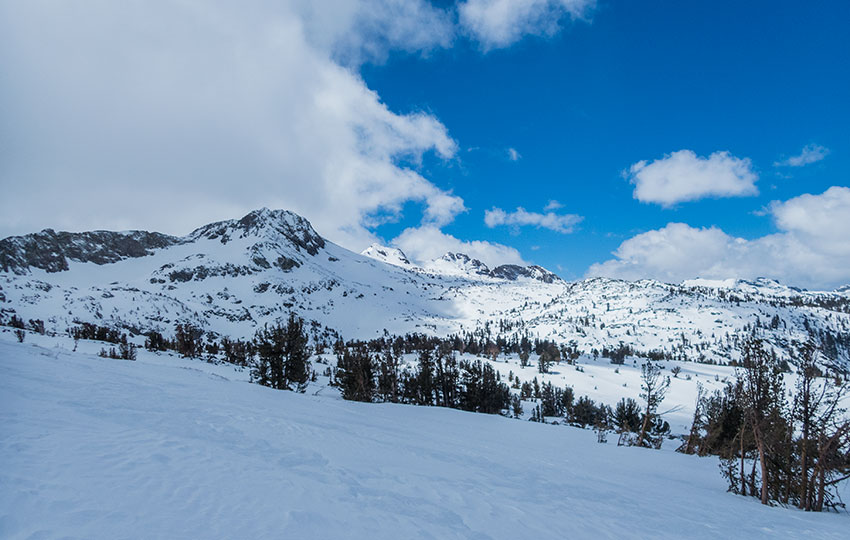
Final Thoughts about Using One Set of XC Ski Boots for Multiple Skis
Reading between the lines, what I’m ultimately saying is that there’s an ideal marriage between cross-country boots, bindings, and skis. And you want them to be commensurate based on their anticipated workload. So, one pair of boots (and related bindings) probably won’t be appropriate for all the styles of cross-country skiing that you’ll perform.
All of that said, I often incorporate multiple techniques from each cross-country skiing style into my outdoor adventures. For example, I like to mix in skate skiing techniques in the backcountry in spite of running much larger and heavier boots, bindings, and skis. I’ll also incorporate short bursts of skate skiing into a quick 5km lunch break classic ski session just for fun. And, that’s while using traditional classic boots that don’t offer any ankle support.
Keep in mind, however, that you can’t diagonal stride on skate skis because they don’t have a grip zone and skate ski boots are too stiff (for striding).
Does this mean that you could actually just use one set of boots for everything? No.
I just wanted to illustrate the point that there’s tons of flexibility within all aspects of cross-country skiing. But there are also limits. Just because I can skate in classic boots on classic skis doesn’t mean that I would intentionally go out and do that for a whole skate ski workout. What I’m talking about here is the freedom of movement inherent within cross-country skiing in general.
Get the right tool for the job, but don’t be afraid to push its limits a little.
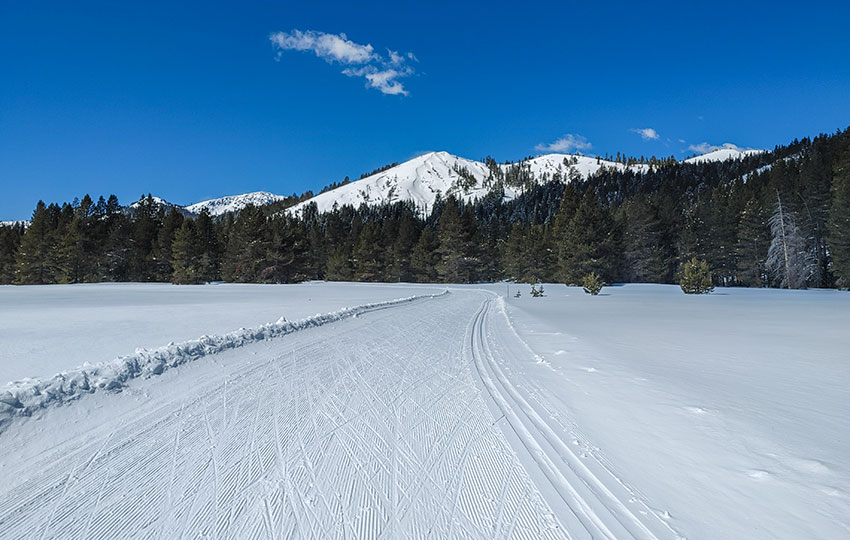
In the end, I recommend investing in a set of dedicated track skis, NNN bindings, and comfortable classic boots for use at a groomed xc ski area. Then, buy a dedicated set of backcountry cross-country skis with a backcountry-oriented binding system (and compatible backcountry boot).
You’ll be happiest with that combination rather than trying to make due with too small of a binding/boot for the backcountry, or too large of a binding/boot for groomed terrain. And, by owning both sets you’ll extend the life of all your gear because none of it will be performing double-duty.
Cross-Country Downhill #ad maybe slightly dated (published c. 1987), but it provides some wonderful philosophy about cross-country skiing off the beaten path.
There’s also a lot of technical information regarding learning the Telemark turn on lighter cross-country touring gear. Highly recommended for those of you looking to cross-country ski in the backcountry.
Keep in mind, however, that this book is written with a more advanced mountain adventurer in mind. Follow the Amazon link and you should be able to find a used copy.I’m not sure of the current price that these books are selling, but when I bought my copy years ago they were very affordable.
Cross-Country Skiing Explained Articles and Videos
Please note that I wrote and produced the Cross-Country Skiing Explained series of articles and videos with the beginner and intermediate cross-country skier in mind. This is the demographic for whom I most often serve(d) while working in the outdoor recreation industry at Lake Tahoe. I basically treat these articles and videos as extensions of the conversations that I have (had) with those customers.
That said, expert skiers probably could take away something of value from these resources. Just know that I don’t address race-oriented philosophy, technique, or gear selection.
Considerations for buying cross-country ski gear (new and beginner xc skiers)
- Intention, Types of XC Skis, and Whether to Buy New or Used (Part 1)
- How Much Gear to Acquire, Evaluate Your Commitment, Value of Taking XC Ski Lessons (Part 2)
- Can One Set of Classic Cross-Country Skis Work for Groomed and Off-Track XC Skiing? (Part 3)
- Can I Use One Set of XC Ski Boots for All of My Cross-Country Skiing Needs? (Part 4)
- Overview of Off-Track and Backcountry Cross-Country Ski Gear
- Invest in Technique More than Gear
Classic Cross-Country Ski Components
- Introduction to Classic Cross-Country Skis (Part 1)
- Geometry of Classic Cross-Country Skis (Part 2)
- The Grip Zone of Classic Cross-Country Skis (Part 3)
- Types of Bindings for Classic Cross-Country Skiing (Part 4)
- Ski Boots for Classic Cross-Country Skiing (Part 5)
- Classic Cross-Country Ski Poles (Part 6)
- FAQs about Classic Cross-Country Skiing
Waxing Your “Waxless” Cross-Country Skis (for beginner and intermediate xc skiers)
- Introduction to Waxing Your Waxless XC Skis
- Step-by-Step Waxing Tutorial
- FAQs About Waxing Your Waxless XC Skis
Cross-Country Skiing Techniques, Demonstrations, and Related Concepts
- Outdoor VLOG (emphasis on the cross-country skiing experience)
- Cross-Country Skiing in Challenging Conditions
- Considerations for Winter Adventure in Lake Tahoe’s Backcountry
- Using the Side-Step and Herringbone Techniques in the Backcountry
- 10 Tips for Spring Cross-Country Skiing in the Backcountry
- 5 Reasons to Love Spring Cross-Country Skiing
- Considerations for Cross-Country Skiing During the Fall and Early Winter
- Discussing the Goal of Becoming a Better Cross-Country Skier and Embracing Backcountry and Groomed Terrain in Pursuit of that Goal
- The Cross-Country Skiing Experience: Immersing Yourself in Winter
Thank you! So very helpful!
You’re welcome! Glad I could be of service 🙂 And let me know if you ever have any specific questions. I’m more than happy to offer any/all feedback that I can!
Houghton? Did you go to Michigan Tech?
Hey J.M. Yes, I did graduate from Michigan Tech back in 1999. Although I got a BA in Technical Writing, not any type of engineering. I grew up in the UP, so I returned to go to college there 🙂